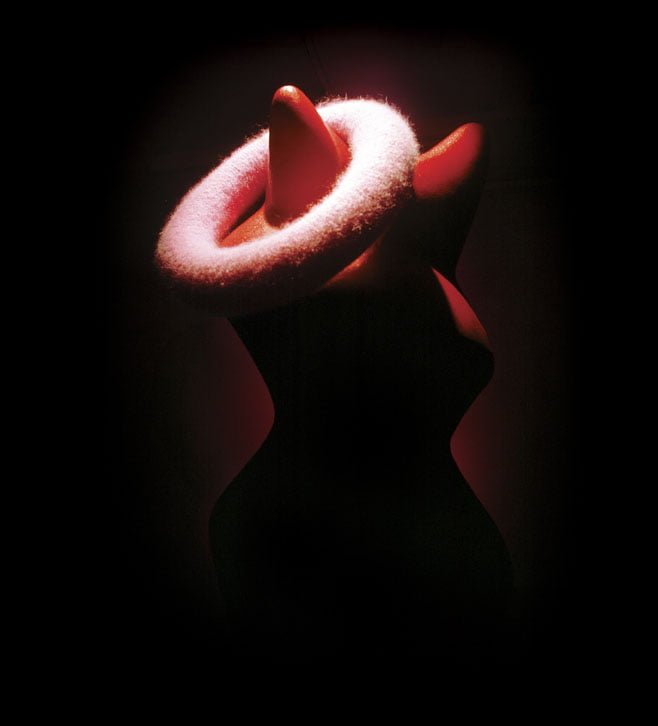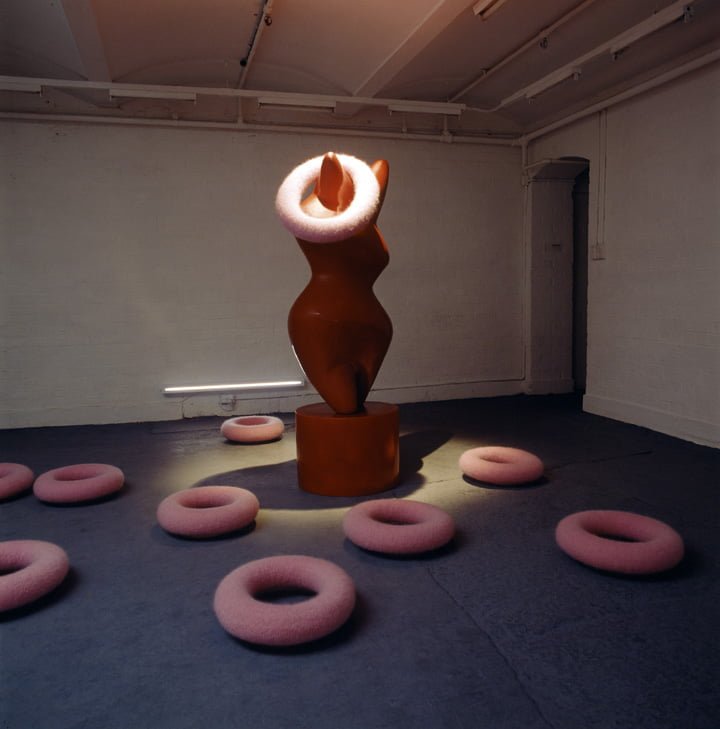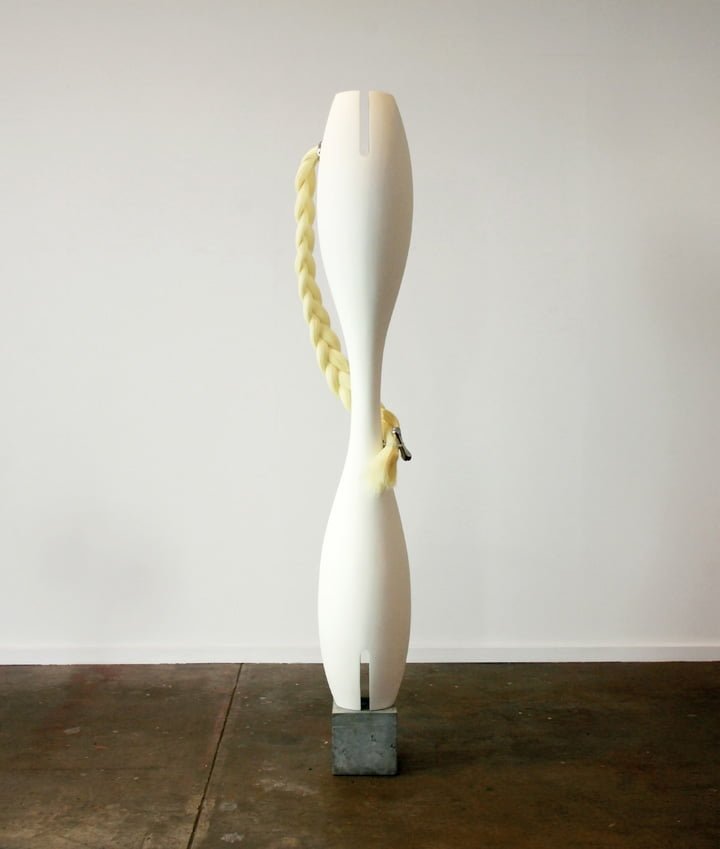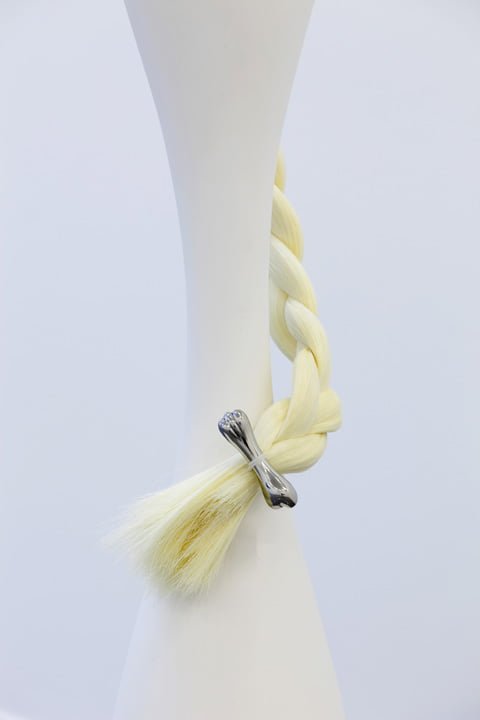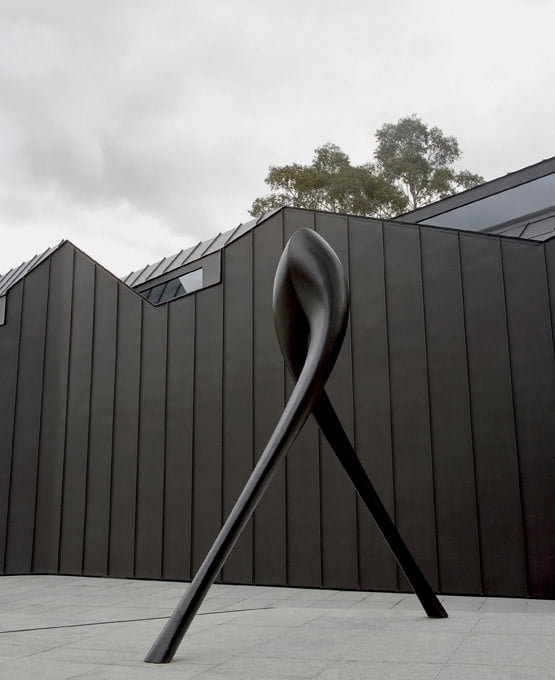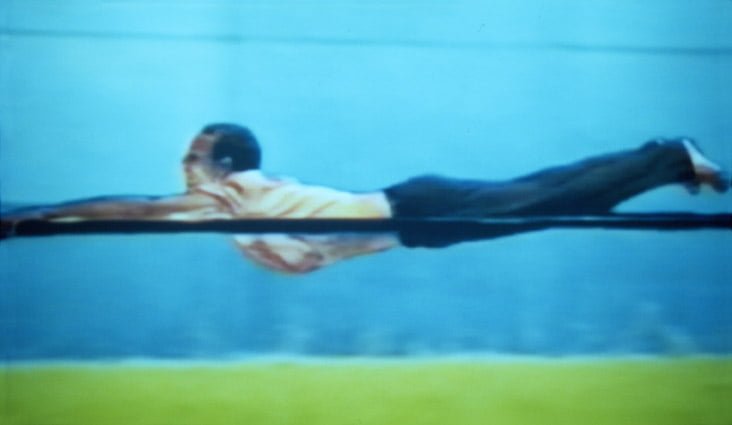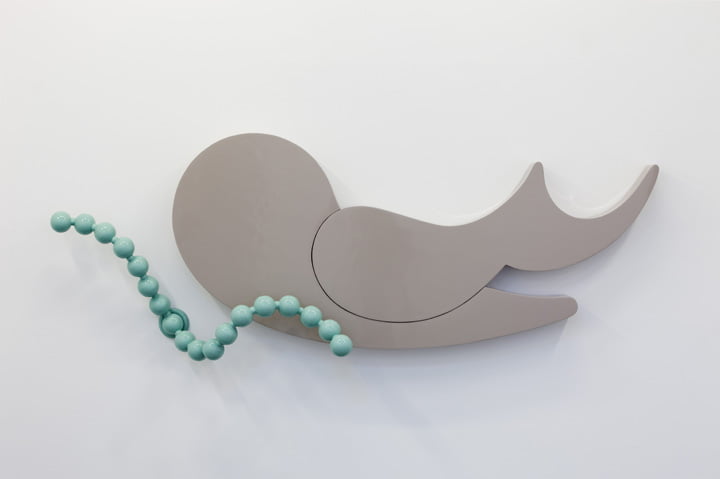Objects to Live By: The Art of John Meade—
Artists: John Meade
Objects to Live By / The Art of John Meade is the first exhibition to review fifteen years of practice from one of Australia’s leading sculptors. Meade’s oeuvre is distinguished by its synthesis of figuration and abstraction. In dissolving the distinctions between sculpture, modern design and everyday objects, his art is a catalyst for the imagination.
Text by Georgia Cribb, Director, National Exhibitions Touring Support (NETS) Victoria
My earliest direct encounter with the art of John Meade occurred relatively recently, in the artist’s studio. In production were some of his most recent works of art including Sabrina (2009). Chance encounters with found objects are the starting points for Meade’s complex, carefully constructed and often witty, works of art. In the studio space these reference points were interspersed within an array of sculptural forms that were in various stages of completion.
Meade’s works reference various artistic conventions of the twentieth century whilst continuing to be at the forefront of contemporary art practice. His use of unconventional forms and industrial synthetic materials, such as polymer resin composites and concretes, sit in contrast to those employed by his four fellow studio artists, each working within more traditional sculptural conventions, at the historic Gasworks Arts Park, Albert Park. Unexpectedly however, many of the slick, seductive surfaces of Meade’s work that appear machined finished are actually laboriously hand crafted.
As one of Australia’s leading sculptors, Meade has presented works as part of a multitude of important group exhibitions such as 21st Century Modern, Adelaide Biennial of Australian Art, Art Gallery of South Australia (2006); This was the future… Australian Sculpture of the 1950s, 60s, 70s and Today, Heide Museum of Modern Art; and Orifice, Australian Centre for Contemporary Art (2003). Objects to Live By is the first occasion that a significant body of this artist’s work, traversing twenty years and ranging in scale and media, has been brought together for a national touring exhibition.
Meade’s oeuvre comprises work that is scaled to both domestic and gallery interiors, and to outdoor and architectural contexts. Whilst Meade’s major outdoor commissions are not able to be seen within the context of this exhibition, they are profiled both within the exhibition catalogue and the film commissioned specifically for this project.
The logistics of moving large scale, three dimensional works of art around the country can be prohibitively complex for many artists and organisations. We are grateful to the artist and curator for their incredible commitment and enthusiasm in bringing this exhibition to audiences across the country, and thankful to the significant support received for this touring exhibition from the Federal government’s Visions of Australia program.
We are pleased to present Australian audiences with Objects to Live By / The Art of John Meade – a significant body of work from an outstanding artist.
John Meade in conversation with the exhibition curator
Zara Stanhope: John, you create objects that exist only in the imagination until given form. Yet, your sculptural works contain memories or partial traces of things already in the world, their origins perceptible to differing degrees. Even when finely filtered, your formal vocabulary is resonant with the matter, feelings and relations that are activated in the zones between solids and spaces. As a language it is an intersubjective synthesis of many parts. Have particular sources been important for the distinctive forms that have arisen in your practice?
John Meade: It is important for me to create new form; it is one of the tasks I have set myself. But the form usually has its beginning somewhere in the material world: a piece of foam rubber found in the street, a large red car wash brush spotted on the back of a truck, an old stool with the seat missing retrieved from the other side of a cyclone fence. At these moments the light catches my eye. This type of practice is akin to the Henry Moore flint rock thing, where stones he found on walks would suggest certain sculptural forms. My process is more Flintstones than flint rock. It is a classic case of the artist responding to their surroundings, a subjective experiment where an engagement with the outside world produces some sort of new form.
There are many inspirations behind my work and all is up for grabs. Over the years, much of my reading has been on the psychological mechanisms active in the process of making art. Slavoj Žižek has been a favourite. For a bit of Freudian/Marxist romanticism on art, you can’t go past Herbert Marcuse. At the moment, I am enjoying Carl Jung’s writings on psychic phenomena, myth and the nature of belief. It is not that I get my ideas from these readings but that my thinking is confirmed and further activated by them. In considering this list, it is really apparent to me that I am a product of the age that I was born into, 1956: a time of post war optimism and the rise of secular humanism, the birth of television in Australia, atomic age design, rock music . . .
ZS: In that regard, are there elements of art that you feel are connected to the subconscious? What is the process of development of individual sculptures, do works have a long period of evolution rather than arising as fully formed concepts? And is the conception of work a process you can only properly understand in retrospect?
JM: The unconscious usually deals with the same stuff of the world as the conscious mind. However, as it operates on a pre-linguistic level, as can art, things don’t always make sense. There are certain characteristics that could be seen to run through this type of art work, for example, the use of a narrative structure and the creation of a ‘scene’, the appearance of pre-historic and mythological entities, etc. It is best not to get caught up in the style of these types of features though, because they can too easily become an affectation.
Things always happen differently. In making the earlier installations, the premise or the context for a body of work would often be set from the start.Acrobats of Love (1994) is a line from a song, The Great Valerio by Richard and Linda Thompson, which suggested a particular way of establishing a series of objects. Similarly, Hauler Me (1999) was based on a recurrent dream I had as a child. At the time, these concepts would seem to break through into consciousness reasonably whole. In retrospect, they were probably less spontaneous than I believed because the details of the ensemble of sculptures would be only partially formed in these initial visualisations, and so would require research and further development over time. On completion, I would be under the impression the work was true to my original conception.
For most of the last decade, however, this has not been the case, possibly because I have quite purposely moved away from installation and site-specific work. I have wanted the sculptures to be stand-alone and to not require an overarching concept or spatial dynamic to pull them together. I learned a lot by undertaking the installation work but ultimately found it too restricting. I wanted to be able to break components up and show them anywhere. This shift was also a way of extending my life as a sculptor. I didn’t want all my ideas to arrive conceptually complete and self-conscious because I have seen other artists lose steam in working that way. Now, each sculpture is approached individually and its problems are processed separately. I often do this working through at a maquette stage, so if it requires scaling up I already know the work well.
ZS: Although you are claiming autonomy for individual sculptures, there are, however, definite connections across certain works, such as formal similarities evident between the small scale Nude with Pitchfork (2002) andAqualung (2006), the large outdoor sculpture in Melbourne’s Docklands. This suggests an interest in the elaboration of form over time. Are these connections between works deliberate or again, is it something you only become aware of in retrospect?
JM: The similarity between Nude with Pitchfork, Aqualung and Progeny(2004-5) is no accident. I was working on Nude with Pitchfork when the invitation came to propose a work for an outdoor public sculpture in Melbourne. Nude was taking a really long time to develop and, although I wanted to participate in the commission, I didn’t want to lose my focus on the sculpture at hand. So the mountain came to Mohammad and Aqualung was developed as a streamlined version of Nude with Pitchfork.
Progeny made its first appearance in an exercise that was set for a technical class I was taking at NYU. I happened to have an Aqualung maquette with me so I made a mould, cast two new Aqualungs and found that they fitted perfectly when both were joined together at the base. Beyond the practical, the reason why these forms persisted, and the reason why Nude was taking so long to develop was because at the time I thought it to be the closest I had come in attempting to create an original form. Although Nude was sourced from another (found) object, through the pro-cess of rendering it relinquished most of its origins.
Lately I find that I am starting to riff on some of my old work. This is a good place to be because it brings a longer perspective to a developing style and allows me to appreciate what I do today. I recently set up some sculpture that I had made in third and fourth year art school and I think it stands up alongside what I might do now. However, there are not always stylistic connections between works because at various times I wanted to have a go at everything and at certain points took inappropriate turns. It can be difficult to stay on track because you, the artist, are marking out the route alone.
ZS: Turning to production, the fabrication of your sculptures is often time consuming, involving building up forms and creating finishes by hand, processes that you undertake yourself. Often a great deal of time and effort is absorbed in determining how to fabricate works or customising components of sculptures. Even when existing or found materials are integrated in sculptures, as we see most recently in Sabrina (2009), they can require onerous re-modelling. How are ideas, forms and materials interrelated within the processes of your art making? At which stage in a work are the elements of materiality and surface conceived? How central are these two qualities to sculpture?
JM: For some reason I have always been attracted to the surfaces of objects. This may be an interest in tactility, yet I don’t particularly like decorative detail in sculpture. It might also be an attraction to the light reflected on an object. Additionally, it could relate to the need to erase the irregularities in the surface I am working on, which can develop into a type of neurosis.
In many ways works are restricted by my limited resources, and perhaps this is a good thing. I really appreciate the surfaces of Jeff Koons’ tinted stainless steel sculptures. Similarly, Charles Ray achieves a great result with his recent painted stainless cast works. I have been so impressed by Donald Judd’s work. All of this sculpture reflects a level of material sophistication achieved in industry but none of it is really me. It may be one day but it isn’t at present. So I need to take these influences and somehow do what I can. My resolution is that I bring my own hand to creating forms that carry that hand. This can be quite frustrating and time consuming because I am trying to achieve industrial standard forms and outcomes manually and, therefore, every piece is necessarily a failure on some level. For example, I have attempted (impossibly) to produce many spherical forms through continual rendering but something happens in this repeated rendering that would not occur in a fabricator’s workshop. Hopefully, it brings a sort of a warmth to the form, warmth that emanates from within, not just from the surface.
I have a theory that, as viewers, we can discern certain qualities in material beyond the surface. At the moment I am interested in density. I prefer a surface that is integral to the material of the whole, and if this is not possible then the work needs the quality of a convincing material density beyond an applied surface. This is why Charles Ray’s recent white sculptures are so interesting; the quality of their surfaces is derived from the density and hardness of the stainless steel underneath.
I am becoming increasingly more serious about material because I have been so frustrated by my less than successful past experiments, particularly with plastics. I don’t have any issue with the traditional sculptural materials of bronze, steel and ceramics. Every material has its own particular characteristics that can make it more suited to a certain form or idea but sometimes the choice of a material is really just a means to an end, as in the durability required for outdoor sculpture. Recent developments in fibreglass and resin composites have been extraordinary and I have used them often because they are so readily available, malleable and afford-able. At the moment, I am also fond of concrete and cast iron for their rawness and weight.
ZS: Returning to subject matter, the human body is a strong presence in your sculpture, in addition to the works’ interconnections with the surrounding world. I am thinking not only of the figurative sculptures or the traces of labour in the surfaces of works but also the sense of physicality or even the absence of the body that certain works exude. Impostor (1995),Women in Love (2005), Baby Misere (2006) and other sculptures includingSelf Portrait as Mary Magdalene (2003-09) all reference the human form but so do certain abstract objects, for example Double Pin with Heidi Plait(2008). Heavily solid torsos appear, as do hollowed-out shapes. There are allusions to the body’s vulnerability and porousness in the video Propulsion(2001). Even the tables evoke their missing users. Although the figurative references are often abstract, they imply wily associations with flesh or bodily subjectivities without literally representing figures or human behaviour. To what degree are many of your works ‘from life’?
JM: Just about everything I do in my sculpture is measured by my body. This is possibly why I became a sculptor and why I call myself a sculptor rather than an artist. It also relates to a particular facility with bodily representation-I don’t know what this facility is called but it has something to do with eye/hand coordination and an ability to insert form in space. It is also related to the way the figure has been represented throughout the history of sculpture and the need for us as a species to portray ourselves. But I do not have a facility with traditional academic modes of realistically portraying the figure, either through drawing or modelling. And this is probably because I have come to the figure late in my artistic practice. I more closely relate to the abstraction of the body in space by the early proponents of modern dance, such as Martha Graham.
ZS: Indeed, there is a perceptible sympathy between your work and the bodily and cultural exploration of space in twentieth-century contemporary dance-I was thinking of the repertoire of British choreographer Michael Clark. This ability of your objects to enliven space, often theatrically, was also apparent in After Math, the text you wrote for a previous exhibition.Have you ever thought of yourself as a director or orchestrator of an event-space or of your art inhabiting a space in advance of some future encounter?
JM: When I worked with specific spaces I always thought of them as a site where something was happening or could happen or had already happened.Impostor was an early example of this: a set of sculptures arranged in the back room of a basement space. To access this space, the viewer entered a rather narrow hallway off the street, descended a spiral staircase and then proceeded along another narrow corridor to a room. In this space was a scenario involving a couple of sculptures implicated in some sort of back room meet. One sculpture was a small version of the other, and it was watching the scene from behind a vertical H-beam. It was a primal scene but the action was frozen as if everything had stopped at the moment the viewer entered the room. It was reminiscent of the moment when a child is caught out by its parents-the protagonists in the scene were trapped in the glare of the viewer’s gaze.
The installation of Impostor operated on many levels. It engaged the subterranean architecture of the building, which correlated to multiple levels of the human psyche. After I had made the work I realised that my response to the environment was more sophisticated than I could have consciously constructed. Although I didn’t comprehend it at the time, the space was treated as the final point of a labyrinth and the red figure with two horns was a minotaur devouring a pink flesh/ring. This experience broadened my understanding of human intelligence and it convinced me that in making art I could draw on all sorts of faculties, whether I was aware of them or not.
ZS: Another back room space is the studio. Your studio seems more like a site of production than a contemplative space, but when I visit my eyes are always drawn to a number of postcards and reproductions pinned to one wall. These include images of a plump curling soft serve ice-cream, Sweet Pea from Popeye cartoons, a Hans Bellmer poupée and an Arp sculpture. Such selections mirror other interests that can be indentified in your work in general; the eclectic mix of popular design, modern art, film culture and passionate or sensual life. How do you reflect on the modern avant-garde’s belief in a place for art in life?
JM: Regarding the pictures on the wall in the studio, I think they all bear a resemblance to Casper the Friendly Ghost. When I was a child I had very catholic tastes and Casper was so nice and round. Later on I loved the Michelin Man. Big, round and white. Most of the pictures-the Dairy Queen, Sweet Pea, the painted aluminium Doll sculpture of Hans Bellmer from 1936-all share those qualities of voluminous, round, white forms. Think of the stack of eggs in the work Nighttime#2, the climbing holds from Hauler Me, Sunday Devotional . . .
Do you know of that lovely flow chart by Alfred Barr illustrating his chronological schema on the development of abstract art? Well, I subscribe to the non-geometric form of abstraction that arises out of abstract expressionism, dada and surrealism. And, given the turns and returns that radical art has taken in the last century or so, I quite enjoy Hal Foster’s theory that artistic conventions return to reposition themselves in new spaces and new times. The drive and intention may change each time because the conditions are different but this revisioning is what culture does really well, especially when it presents new options out of the past. Today we don’t emphasise the linear development of art and yet the historical sources are there for the taking, and to the mix we add all sorts of forms from the everyday. I think life has a habit of inserting itself into art and I don’t think this is going to stop soon. I like the second register of life that comes through art, not just the source material but the subtleties of conception that artists develop around this material seen in for example, the phenomenological aspects of minimalism, the poetry in Agnes Martin’s grids and the insistent hysteria in Warhol’s repetition. Art is very adroit at conveying these sorts of complex human dynamics.
October 2009
Learning Guides
-

John Meade Impostor (detail) 1995
Polyurethane and mohair
200.0 x 100.0 cm; four parts
11.0 x 50.0 (diam.) cm each; overall dimensions variable
Private collection, Melbourne
Courtesy the artist and Sutton Gallery, Melbourne -

John Meade Impostor 1995
Polyurethane and mohair
200.0 x 100.0 cm; four parts
11.0 x 50.0 (diam.) cm each; overall dimensions variable
Private collection, Melbourne
Courtesy the artist and Sutton Gallery, Melbourne -

John Meade Double Pin with Heidi Plait 2008
Polyester resin, fibreglass, pigment, calcium carbonate, plastic industrial bristle, stainless steel and concrete
200.0 x 40.0 x 40.0 cm
Courtesy the artist and Sutton Gallery, Melbourne -

John Meade Double Pin with Heidi Plait (detail) 2008
Polyester resin, fibreglass, pigment, calcium carbonate, plastic industrial bristle, stainless steel and concrete
200.0 x 40.0 x 40.0 cm
Courtesy the artist and Sutton Gallery, Melbourne -

John Meade Progeny 2004–2005
Fibreglass reinforced concrete, pigment and steel
230.0 x 2.30.0 x 45.0 cm
Heide Museum of Modern Art, Melbourne
Purchased through the Heide Foundation 2006
Photo: John Gollings
Courtesy the artist and Sutton Gallery, Melbourne -

John Meade Propulsion 2001
Still from 2 screen video transferred to DVD
1.11 min. duration, looped
Courtesy the artist and Sutton Gallery, Melbourne -

John Meade Sabrina 2009
Steel and Styrofoam insulation, polyester resin, fibreglass, mild steel, stainless steel and automotive paint
108.0 x 278.0 x 44.0 cm
Courtesy the artist and Sutton Gallery, Melbourne -

John Meade Self portrait as Mary Magdalene 2003–2009
Polyester resin and pigment, human hair, Reducit, bamboo, wood
80.0 x 130.0 x 30.0 cm
Photo: Peter Matra
Courtesy the artist and Sutton Gallery, Melbourne
Venues
-
Latrobe Regional Gallery
06.02.10 - 04.04.10 -
Academy Gallery - University of Tasmania
16.04.10 - 28.05.10 -
Swan Hill Regional Art Gallery
16.07.10 - 29.08.10 -
Perth Institute of Contemporary Arts
11.09.10 - 24.10.10 -
Orange Regional Gallery
11.03.11 - 24.04.11 -
Tamworth Regional Gallery
14.05.11 - 25.06.11

